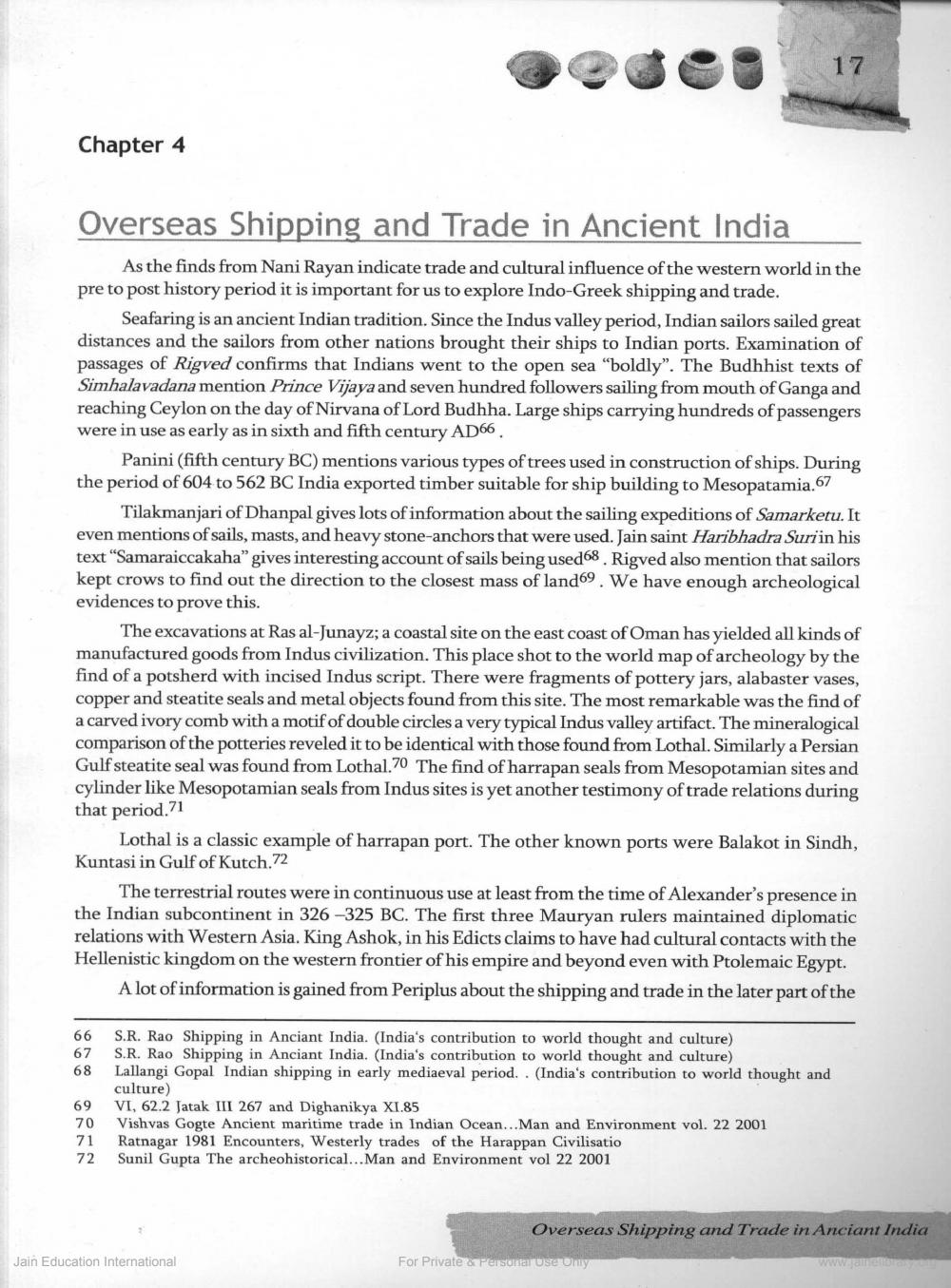________________
Chapter 4
Overseas Shipping and Trade in Ancient India
As the finds from Nani Rayan indicate trade and cultural influence of the western world in the pre to post history period it is important for us to explore Indo-Greek shipping and trade.
Seafaring is an ancient Indian tradition. Since the Indus valley period, Indian sailors sailed great distances and the sailors from other nations brought their ships to Indian ports. Examination of passages of Rigved confirms that Indians went to the open sea "boldly". The Budhhist texts of Simhalavadana mention Prince Vijaya and seven hundred followers sailing from mouth of Ganga and reaching Ceylon on the day of Nirvana of Lord Budhha. Large ships carrying hundreds of passengers were in use as early as in sixth and fifth century AD66
Panini (fifth century BC) mentions various types of trees used in construction of ships. During the period of 604 to 562 BC India exported timber suitable for ship building to Mesopatamia.67
Tilakmanjari of Dhanpal gives lots of information about the sailing expeditions of Samarketu. It even mentions of sails, masts, and heavy stone-anchors that were used. Jain saint Haribhadra Suriin his text "Samaraiccakaha" gives interesting account of sails being used68, Rigved also mention that sailors kept crows to find out the direction to the closest mass of land69. We have enough archeological evidences to prove this.
17
The excavations at Ras al-Junayz; a coastal site on the east coast of Oman has yielded all kinds of manufactured goods from Indus civilization. This place shot to the world map of archeology by the find of a potsherd with incised Indus script. There were fragments of pottery jars, alabaster vases, copper and steatite seals and metal objects found from this site. The most remarkable was the find of a carved ivory comb with a motif of double circles a very typical Indus valley artifact. The mineralogical comparison of the potteries reveled it to be identical with those found from Lothal. Similarly a Persian. Gulf steatite seal was found from Lothal 70 The find of harrapan seals from Mesopotamian sites and cylinder like Mesopotamian seals from Indus sites is yet another testimony of trade relations during that period.71
Lothal is a classic example of harrapan port. The other known ports were Balakot in Sindh, Kuntasi in Gulf of Kutch.72
The terrestrial routes were in continuous use at least from the time of Alexander's presence in the Indian subcontinent in 326-325 BC. The first three Mauryan rulers maintained diplomatic relations with Western Asia. King Ashok, in his Edicts claims to have had cultural contacts with the Hellenistic kingdom on the western frontier of his empire and beyond even with Ptolemaic Egypt.
A lot of information is gained from Periplus about the shipping and trade in the later part of the
66
67
68
69
70
71
72
S.R. Rao Shipping in Anciant India. (India's contribution to world thought and culture) S.R. Rao Shipping in Anciant India. (India's contribution to world thought and culture) Lallangi Gopal Indian shipping in early mediaeval period.. (India's contribution to world thought and culture)
VI, 62.2 Jatak III 267 and Dighanikya XI.85
Vishvas Gogte Ancient maritime trade in Indian Ocean...Man and Environment vol. 22 2001 Ratnagar 1981 Encounters, Westerly trades of the Harappan Civilisatio
Sunil Gupta The archeohistorical... Man and Environment vol 22 2001
Jain Education International
Overseas Shipping and Trade in Anciant India For Private & Personal Use Only
www.jallelibrary.car




